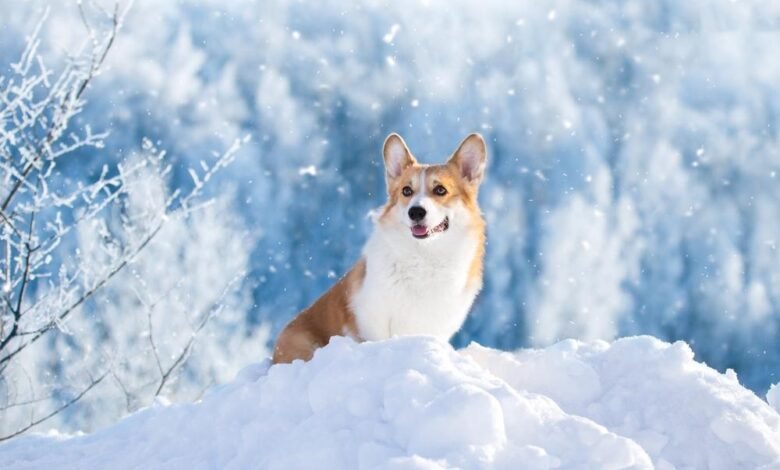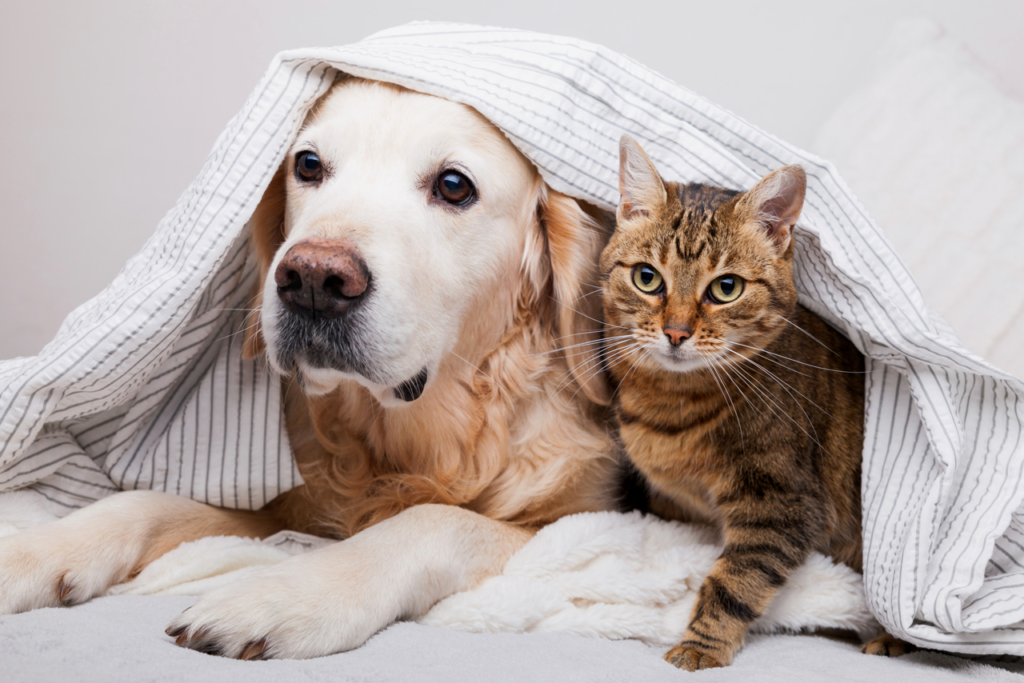
How to Keep Pets Safe During this Winter?
Winter is a magical season filled with festivities, but it also presents challenges, especially for our furry companions. As pet owners, it’s our responsibility to ensure the safety and well-being of our pets in the colder months. In this comprehensive guide, we’ll explore practical tips and insights on safeguarding our beloved four-legged friends and pets safe during this winter.
Read More: Pet Safety: Identifying Household Hazards and Preventing Accidents
Understanding Pet Vulnerabilities

Dogs and their Cold Tolerance
Dogs, with their diverse breeds, sizes, and coat types, respond differently to winter weather. While some breeds thrive in the snow, others may struggle with the cold. It’s essential to recognize your dog’s cold tolerance and tailor outdoor activities accordingly.
Some dogs, like Siberian Huskies or Alaskan Malamutes, are naturally equipped for colder temperatures. However, short-haired breeds, elderly dogs, or those with health issues may need extra care in winter. Watch for signs of discomfort, such as shivering, lifting their paws, or curling into a tight ball.
Cats and their Winter Challenges
Cats, known for their independent nature, may face unique challenges during winter. Unlike dogs that may enjoy the crisp air, cats often seek warmth in unexpected places. Indoor heating can lead to dry skin, and understanding feline behavior in colder months is crucial.
Provide cozy blankets and heated beds for your cat to snuggle in. Additionally, consider placing these in quiet, warm spots where they can retreat when the temperature drops. Observing your cat’s behavior helps you cater to their needs effectively.
Signs of Cold Stress in Pets
Recognizing signs of discomfort in pets is crucial for their well-being. Dogs may exhibit physical signs such as shivering, lifted paws, or a tucked tail, indicating that they are feeling the cold. In contrast, cats may display behavioral changes like increased hiding, seeking warmth, or becoming more aloof.
Physical Signs in Dogs
Watch for subtle cues in your dog’s behavior. If you notice curled paws or excessive shivering, it’s a clear indication that they’re feeling the cold. Taking prompt action, such as bringing them indoors or providing additional insulation, can make a significant difference.
Behavioral Changes in Cats
Cats may become more elusive or seek out warm spots in response to the cold. If you observe changes in your cat’s behavior, such as increased hiding or a preference for warmer areas, consider providing additional cozy blankets or investing in a heated cat bed.
Creating a Warm Shelter
Ensuring that pets have a warm and comfortable shelter is paramount during winter. Whether your pet lives indoors or outdoors, proper bedding and insulated shelters are essential for their well-being.
Proper Bedding for Dogs and Cats
The choice of bedding plays a crucial role in providing insulation and warmth for your pets. Opt for blankets made from materials like fleece, which retain heat effectively. For dogs that spend time outdoors, consider waterproof and wind-resistant bedding to keep them dry.
Importance of Insulated Shelters
For outdoor pets, an insulated shelter is a necessity. This structure protects against harsh winds and low temperatures, offering a safe retreat during winter weather. Ensure that the shelter is elevated, well-ventilated, and large enough for your pet to move around comfortably.
Winter Nutrition for Pets
Adjusting your pet’s diet during the colder months is essential for their overall health and well-being. Outdoor pets, in particular, may require additional calories to generate the heat needed to stay warm.
Special Considerations for Outdoor Pets
Pets that spend extended periods outdoors need a diet rich in energy. Consult with your veterinarian to determine the appropriate nutritional adjustments based on your pet’s breed, size, and activity level. Providing a well-balanced diet supports their immune system and helps them cope with the winter chill.
Supplements for Joint Health in Winter
Cold weather can exacerbate joint issues, especially in older pets. Consider adding supplements like omega-3 fatty acids to their diet to promote joint health. These supplements help maintain flexibility and reduce inflammation, ensuring that your pet remains active and comfortable throughout the winter.
Outdoor Safety Measures
While outdoor activities are vital for pets, safety measures become crucial during winter. Cold surfaces, ice, and road salt can pose hazards to their paws, and smaller pets may be more susceptible to the cold.
Paw Protection for Dogs
Invest in paw booties to shield your dog’s paws from snow and ice. Not only do these booties prevent discomfort, but they also protect against harmful substances like road salt. Wipe your dog’s paws after walks to remove any salt or ice-melting chemicals.
Limiting Outdoor Exposure for Small Pets
Smaller pets, such as rabbits or guinea pigs, are more susceptible to extreme temperatures. Limit their time outdoors, and provide a warm, insulated enclosure. Consider bringing them indoors during particularly cold spells to ensure their safety.
Grooming Practices in Winter

Maintaining your pet’s coat is challenging during winter, but it’s essential for their well-being. Regular grooming prevents matting, enhances circulation, and keeps the skin healthy.
Coat Maintenance for Dogs
Brush your dog’s coat regularly to remove loose fur and prevent matting. This practice not only improves their coat’s insulation properties but also promotes better air circulation, keeping them warmer. For long-haired breeds, consider scheduling professional grooming to maintain their coat in top condition.
Preventing Dry Skin in Cats
Indoor heating can lead to dry skin in cats. Combat this by using a humidifier in your home to add moisture to the air. Additionally, ensure that your cat receives a balanced diet rich in essential fatty acids, which contributes to skin health. If dry skin persists, consult with your veterinarian for specific recommendations.
Winter Pet Fashion
While the idea of pet clothing may seem like a fashion statement, it serves a functional purpose in winter. Choosing the right attire and exploring DIY fashion ideas can add an extra layer of protection against the cold.
Choosing Appropriate Winter Wear
Invest in jackets or sweaters for dogs with short fur, as they are more susceptible to the cold. Ensure that the clothing fits properly, covering their torso and providing adequate warmth. Cats may not tolerate clothing, but cozy blankets or beds can serve as effective alternatives.
DIY Pet Fashion Ideas
Get creative with DIY pet fashion. Knit a small sweater for your dog or repurpose old fabrics into a comfortable bed for your cat. Not only does this add a personal touch to your pet’s winter wardrobe, but it also provides them with additional warmth and comfort.
Holiday Hazards for Pets
The holiday season brings joy and celebrations, but it also introduces potential hazards for pets. From toxic foods to decorations, being aware of these dangers is crucial for their safety.
Toxic Foods for Pets
Certain holiday foods, such as chocolate, grapes, and alcohol, are toxic to pets. Keep these treats out of reach and educate family members and guests about pet-safe snacks. In case of accidental ingestion, contact your veterinarian immediately.
Safety Precautions for Decorations
Decorations, while festive, can pose risks to curious pets. Tinsel, ornaments, and holiday plants like poinsettias can be enticing but harmful if ingested. Secure decorations to prevent pets from accessing them, and opt for pet-safe alternatives when decorating your home.
Indoor Entertainment for Pets
While outdoor activities may be limited during winter, keeping pets mentally stimulated indoors is crucial for their well-being. DIY toys and interactive playtime ideas provide mental and physical exercise.
DIY Pet Toys
Create simple toys using household items. Crumpled paper balls, cardboard boxes, or DIY puzzle feeders engage your pet’s instincts and keep them entertained. Rotate toys regularly to prevent boredom.
Interactive Playtime Ideas
Engage in interactive play with your pet to strengthen your bond and provide much-needed exercise. Use feather wands for cats or tug toys for dogs to encourage movement and mental stimulation. Experiment with different toys to discover what captures your pet’s interest.
Emergency Preparedness
While we hope for the best, it’s essential to prepare for unexpected emergencies during winter. Creating a pet emergency kit and having contact information for emergency vets readily available can make a significant difference in critical situations.
Creating a Pet Emergency Kit
Assemble a pet emergency kit that includes essentials like food, water, medications, medical records, and a first aid kit. Customize the kit based on your pet’s specific needs and update it regularly. Having these items on hand ensures that you’re ready for any unforeseen circumstances.
Knowing Emergency Vet Contacts
Research and keep a list of emergency vet contacts in your area. In emergencies, time is of the essence, and having this information readily available can be a lifesaver. Share this list with family members and pet sitters to ensure everyone is prepared.
Tips for Exotic Pets
Exotic pets, from reptiles to small mammals, have unique needs that require special attention during winter. Temperature control and specific care considerations are vital for their well-being.
Reptiles and Temperature Control
Maintain proper temperature levels for reptiles using heat lamps or heating pads. Research your specific reptile’s temperature requirements and create a warm environment within their enclosure. Consult with a reptile specialist for personalized advice.
Special Considerations for Small Mammals
Hamsters, guinea pigs, and other small mammals may need additional bedding and insulation during winter. Check with a vet for specific guidelines on caring for these pets in colder months. Ensure that their enclosures are placed away from drafts and cold areas.
Community Resources for Pet Owners
Communities often offer resources to support pet owners facing challenges during winter. Shelters, warming centers, and community pet care programs can assist when needed.
Shelters and Warming Centers
Inquire about local shelters and warming centers that may accommodate pets. These resources ensure that both pet owners and their furry companions have a haven during extreme weather conditions. Some communities even offer temporary housing for families with pets.
Community Pet Care Programs
Some communities run pet care programs to assist owners in need. These programs may provide food, shelter, or veterinary care for pets facing winter challenges. Reach out to local animal welfare organizations or community centers to explore available resources.
Building a Winter Routine

Establishing a routine is key to effective pet care during winter. Regular vet check-ups, a consistent exercise routine, and proactive measures ensure a happy and healthy winter for your pet.
Regular Vet Check-Ups
Schedule regular vet check-ups to address any health concerns promptly. Winter can exacerbate existing conditions, so staying proactive with your pet’s healthcare is crucial. Discuss preventive measures and vaccinations with your vet to ensure your pet is protected.
Creating a Winter Exercise Routine
Maintain a consistent exercise routine for your pet, adjusting activities based on the weather. Short, frequent walks or indoor play sessions keep them active and fit. Consider engaging in activities that cater to your pet’s specific needs and energy levels.
Conclusion on Pets Safe During this Winter
Winter pet care is more than providing warmth; it’s about understanding and meeting the unique needs of our furry companions. By being proactive, recognizing signs of discomfort, and implementing practical measures, we can ensure a safe and enjoyable winter for our pets. Remember that each pet is an individual, so tailor your care routine to suit their specific requirements.
Read More: Summer Pet Safety Checklist
Frequently Asked Questions (FAQs)
- Can I use regular blankets for my outdoor dog’s shelter? While regular blankets provide some insulation, it’s better to invest in materials designed for outdoor use. Look for waterproof and insulated blankets to keep your dog warm and dry.
- Are there specific winter dangers for indoor cats? Indoor cats may face dry skin issues due to indoor heating. Using a humidifier and providing a balanced diet can help alleviate this problem.
- How often should I groom my pet during winter? Regular grooming is essential, but the frequency depends on your pet’s breed and coat type. Dogs with longer fur may need more frequent grooming to prevent matting.
- What should I include in a pet emergency kit? A pet emergency kit should include essentials like food, water, medication, medical records, and a first aid kit. Customize it based on your pet’s specific needs.
- Can I walk my dog in extreme cold weather? While short walks are generally acceptable, avoid prolonged exposure to extreme cold. Invest in paw booties to protect your dog’s paws, and consider indoor playtime as an alternative.








2 Comments